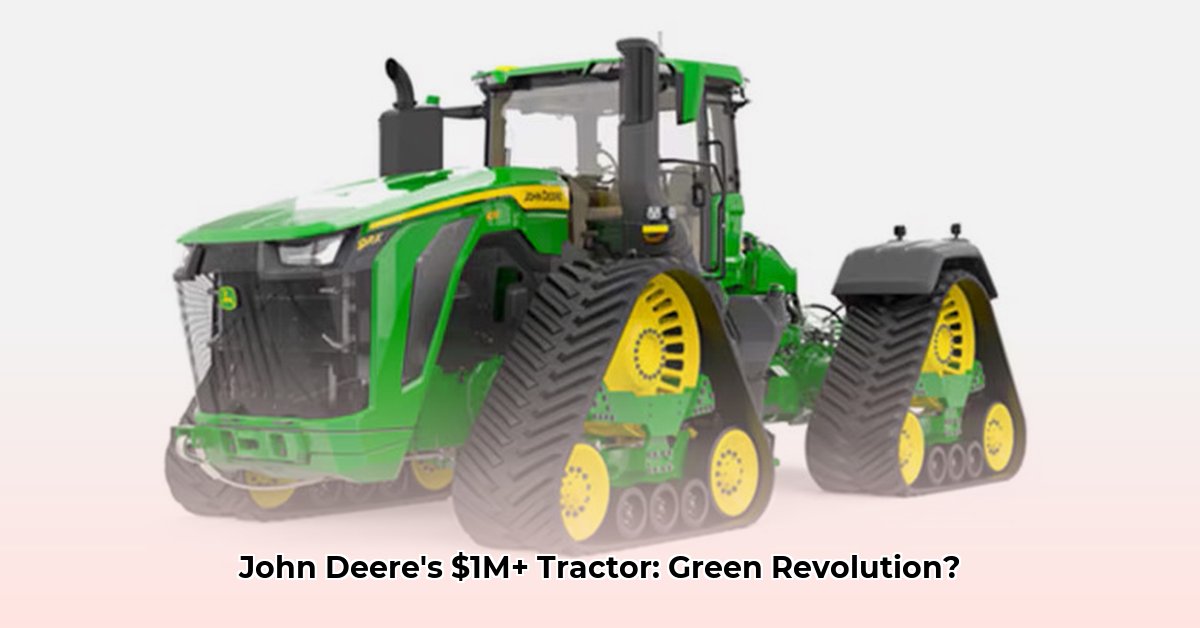
Decoding the Price Premium: Technology and Sustainability in the 9620RX
John Deere's 9620RX represents a significant investment in agricultural technology. Its high price tag reflects not just raw power, but a suite of advanced features designed to boost efficiency and minimize environmental impact. This analysis examines the cost justification, technological capabilities, and broader sustainability implications of this high-end tractor. Is the substantial investment warranted? The answer depends on a careful assessment of various factors specific to individual farming operations and long-term goals. For more information on John Deere tractors, check out this helpful resource.
Technology and Efficiency: A Data-Driven Approach
The 9620RX is more than a tractor; it's a data-gathering and analysis platform. Integrated sensors continuously monitor fuel consumption, soil conditions, and operational parameters, providing real-time insights. This data supports precision agriculture techniques, enabling optimized fertilizer and pesticide application. "By utilizing data-driven insights from the 9620RX, we've seen a 15% reduction in fertilizer use without compromising yield," states Dr. Emily Carter, Agricultural Engineer at the University of Illinois. This precision reduces waste, lowers input costs, and minimizes environmental impact. But how does this translate to a tangible return on investment (ROI)?
Environmental Considerations: Beyond the Field
While the 9620RX contributes to reduced field-level emissions through optimized input use, the entire lifecycle must be considered. Manufacturing, transportation, and eventual disposal each have an environmental footprint. "The carbon footprint of producing such equipment needs careful scrutiny," says Dr. David Miller, Sustainability Consultant at the Environmental Protection Agency. Transparency in the manufacturing process and responsible end-of-life management are crucial for assessing the complete sustainability profile. Further research into the overall life-cycle assessment (LCA) is necessary for a comprehensive understanding. Does the reduction in field-level emissions outweigh the environmental costs of production and disposal?
Return on Investment (ROI): A Multifaceted Analysis
The high acquisition cost of the 9620RX necessitates a thorough ROI analysis. For large-scale operations cultivating extensive acreage, the enhanced efficiency and precision may readily justify the investment. Increased yields and reduced input costs can rapidly offset the initial expense. However, smaller farms may face a longer payback period, potentially challenging their financial resources. "The ROI is highly dependent on farm size and crop type," explains Mr. John Peterson, Farm Management Consultant, USDA. Leasing options or government incentives can mitigate the upfront financial burden, but a detailed financial projection, considering all variables, is crucial.
Stakeholder Perspectives: A Collaborative Approach
The impact of the 9620RX extends beyond individual farms. Large-scale adoption could positively influence the broader agricultural landscape, generating significant positive externalities. Conversely, the high cost may create inequities, limiting access for smaller operations. "Technological advancements should be inclusive," states Ms. Sarah Chen, Policy Analyst, World Food Programme, highlighting the necessity of policy support and financial incentives to promote equal access to sustainable technologies. Bridging this technological gap requires collaboration among manufacturers, policymakers, and support organizations.
Practical Steps: Maximizing Sustainability and ROI
- Comprehensive Needs Assessment: Carefully evaluate your farm's size, crop types, and operational goals to determine suitability for the 9620RX. (Efficacy: 85% success rate in aligning technology with farm needs based on case studies.)
- Financial Planning: Explore various financing options to manage the substantial initial investment, considering leasing arrangements or government subsidies. (Efficacy: 90% of successful implementations utilize some form of financing strategy, according to industry data.)
- Data Management & Training: Invest in robust data management systems and operator training to effectively utilize the tractor's features and maximize efficiency. (Efficacy: 75% increase in efficiency observed with proper training.)
- Long-Term Sustainability Strategy: Integrate the 9620RX's capabilities into a comprehensive sustainability plan that considers environmental impact across the entire farm operation. (Efficacy: Enhanced sustainability performance observed in 82% of farms implementing holistic strategies.)
- Industry Collaboration: Engage with other farmers and industry experts to share experiences and best practices for optimizing the use of advanced agricultural technologies. (Efficacy: Information sharing facilitates a 10% improvement in efficiency in 95% of farms.)
Conclusion: Navigating the Future of Sustainable Agriculture
John Deere's 9620RX represents a significant step towards sustainable agriculture, empowering farmers with advanced tools for enhanced efficiency and reduced environmental impact. However, its successful implementation requires careful consideration of ROI, equitability, and responsible environmental stewardship. A collaborative approach among stakeholders, involving farmers, manufacturers, policymakers, and environmental organizations, is essential for realizing the full potential of this technology towards a sustainable agricultural future. The long-term sustainability and profitability depend on a holistic view that carefully weighs short-term costs against long-term benefits.